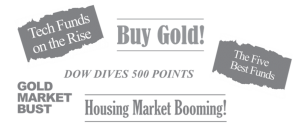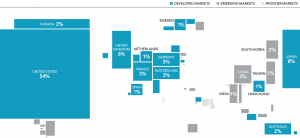The 401(k) Series #2: No 401(k)? No Problem!

Part #1 of this series, The First Step is Signing Up, breaks down the various reasons why Americans aren’t participating, and the steps for signing up for your company sponsored plan. But what if your company doesn’t offer a 401(k)?
Millions of Americans are facing a Retirement Crisis. As we learned from our first piece in this series, only 14% of all American employers offer a 401(k). Not being able to contribute to an employer-sponsored retirement plan is a disadvantage, but it’s one you might be able to overcome. Even if you don’t have a 401(k), you can take the following steps to prepare for retirement.
1. Set up a Traditional IRA
A traditional IRA allows you to save up to $5,500 a year for retirement ($6,500 if you’re over age 50). If you don’t have a retirement plan at work, your IRA contributions are tax deductible. (If you’re married and your spouse is covered by a plan and you’re not, there are contribution limits.) Plus, your savings grow tax-free until you start making withdrawals at retirement.
Setting up a traditional IRA isn’t hard. You can start by figuring out where to open your account. Banks, brokers, and Investment Advisers all offer IRAs. With Park + Elm, you can open a Schwab IRA in a day or two, and begin to fund your retirement. If you’re new to saving, a low or no account minimum is the best place to start. You can set up automatic transfers to fund your IRA.
2. Set up a Roth IRA
A Roth IRA generates tax-free retirement income. Roth IRAs work in much the same way as traditional IRAs, with one crucial difference: The money you contribute can’t be deducted from your taxes. In exchange for giving up the tax deduction today, you get something that might be even better: the possibility of tax-free income in retirement. Roths have a few other perks, as well, such as penalty-free early withdrawals of contributions (though not earnings) and no required minimum distributions at age 70½.
Not sure whether a traditional or Roth IRA is the right choice? It all depends on what tax bracket you think you’ll be in at retirement. If you think your taxes will be higher in retirement than they are today, a Roth is a smart move. If you think your taxes will be lower when you retire, go with the traditional IRA. Keep in mind, there are limitations in regards to who can contribute to a Roth, and how much can be contributed.
3. Look at options for the self-employed
Working for yourself is no excuse not to save for retirement. Self-employed workers and small-business owners have options for saving for retirement beyond traditional and Roth IRAs.
If you work for yourself, consider a SEP IRA, which lets you put away up to $54,000 a year for retirement. Or you could set up a solo 401(k) or SIMPLE IRA. These plans are similar, but you might be able to save more because of slightly different rules regarding those contributions.
If you’re self-employed and considering setting up a retirement plan for your business, talk to a financial professional. They can walk you through the pros and cons of the different options, particularly if you have employees. If you’d like to request a copy of Park + Elm’s Business Owner’s Guide to Saving, please contact Kara at kara@park-elm.com .
Even if your business is a side gig in addition to your full-time job, you can still set up a retirement plan. Shoveling a big chunk of your money into a tax-advantaged retirement account, such as a SEP IRA, could help make up for not having such a plan at your full-time job.
4. Consider the spousal IRA
You can use a spousal IRA to double your yearly retirement savings. Some people aren’t saving for retirement because their employer doesn’t offer a plan, while others aren’t saving because they don’t work. Usually, you need to have earned income to contribute to a retirement account, but the IRS offers an exception for married couples where one person earns little or no income: the spousal IRA.
Spousal IRAs are basically the same as a traditional or Roth IRA, except that the working spouse can contribute an additional $5,500 a year on behalf of their non-working spouse. If neither of you has a workplace retirement plan, the contributions are entirely deductible.
5. Max out your HSA contributions
An HSA is designed to help you cover out-of-pocket medical expenses, but it can also help you save for retirement. Your employer might not have a retirement plan, but another one of your employee benefits could give you a way to save tax-free for retirement: your high-deductible health plan with a health savings account, or HSA.
An HSA lets you put aside $3,400 per year pre-tax ($6,750 per family) to cover out-of-pocket health expenses. The money grows in the account tax-free, and if you use the funds to pay for qualified medical expenses, withdrawals are tax-free, too. And unlike flexible spending accounts, there’s no use-it-or-lose-it provision with an HSA. So your savings add up over time, provided you don’t have a major health crisis that forces you to drain the account.
Considering that your health expenses are likely to skyrocket as you age, setting aside some money now to cover those bills can be a smart move. And if you don’t need the money for health care costs, you can make penalty-free withdrawals after age 65 to cover other living expenses.
6. Save the old-fashioned way
A financial planner can help you choose the right investments when you’re saving for retirement. People love 401(k)s and IRAs because of the tax advantages, but they’re not the only way to save for retirement. Investing in a plain old investment account is another way to build your nest egg. Sure, you won’t get to deduct your contributions from your taxes like you do with a regular 401(k). But you also won’t have to worry about rules regarding withdrawals and contribution limits, which is a big plus for some people.
Capital gains tax can be an issue if you’re investing for retirement outside a 401(k) or IRA, particularly if you’re high-income. But if you’re in the 10% or 15% tax bracket, you won’t have to pay any long-term capital gains tax. Working with an experienced accountant or adviser can help you minimize your tax liability if you’re saving for retirement outside of a 401(k).
According to a World Economic Forum Report, longer life spans and disappointing investment returns will help create a $400 Trillion retirement savings shortfall in about 3 decades. Not having access to a company sponsored 401(k) can be part of this problem. We’ve given you 6 potential solutions to this problem. Feel free to contact our office today if you would like to see if these solutions might fit your individual situation.



 DO YOU PARTICIPATE?
DO YOU PARTICIPATE?




